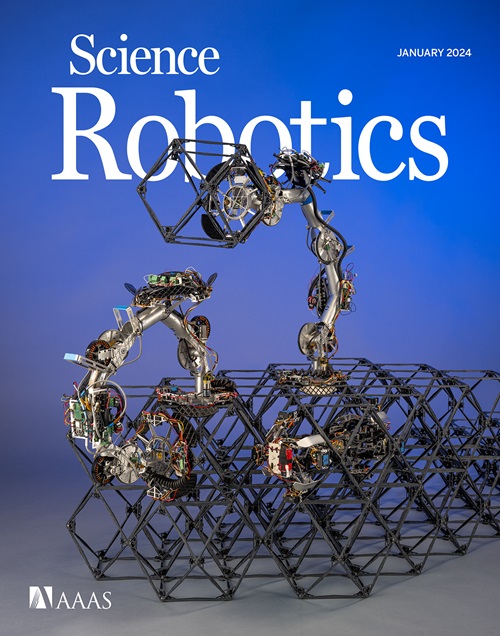Plasticized electrohydraulic robot autopilots in the deep sea
IF 27.5
1区 计算机科学
Q1 ROBOTICS
引用次数: 0
Abstract
Soft robots, with their compliant bodies, minimal environmental disturbance, and ability to withstand ambient pressures, offer promising solutions for deep-sea exploration. However, a common challenge of stiffening in soft materials impairs their effective actuation in harsh conditions. In this work, we integrated a liquid dielectric plasticizer within an electrohydraulic soft robot, serving dual critical functions as a softening agent to maintain the softness of the polymer shell and an electrohydraulic fluid for efficient actuation. In addition, by using the surrounding seawater as alternating electrodes, we prevented charge retention in dielectric layers, enabling sustained actuation performance. Field tests at depths of ~1360, 3176, and ~4071 meters confirmed the robot’s ability to sense the environment, navigate complex trajectories, and withstand unsteady disturbances. Our work offers a generalized and straightforward framework for developing soft materials tailored for deep-sea applications, paving the way for soft robots to execute real-world missions.
塑化的电液机器人在深海中自动驾驶
软体机器人具有柔顺的身体、最小的环境干扰和承受环境压力的能力,为深海勘探提供了有前途的解决方案。然而,软质材料的一个共同挑战是硬化,这削弱了它们在恶劣条件下的有效驱动。在这项工作中,我们将液体介质增塑剂集成到电液软机器人中,作为柔软剂保持聚合物外壳的柔软性,并作为电液流体有效驱动,具有双重关键功能。此外,通过使用周围的海水作为交替电极,我们防止了介电层中的电荷保留,从而实现了持续的驱动性能。在~1360、3176和~4071米深度的现场测试证实了机器人感知环境、导航复杂轨迹和承受不稳定干扰的能力。我们的工作为开发适合深海应用的软材料提供了一个通用而直接的框架,为软机器人执行现实世界的任务铺平了道路。
本文章由计算机程序翻译,如有差异,请以英文原文为准。
求助全文
约1分钟内获得全文
求助全文
来源期刊

Science Robotics
Mathematics-Control and Optimization
CiteScore
30.60
自引率
2.80%
发文量
83
期刊介绍:
Science Robotics publishes original, peer-reviewed, science- or engineering-based research articles that advance the field of robotics. The journal also features editor-commissioned Reviews. An international team of academic editors holds Science Robotics articles to the same high-quality standard that is the hallmark of the Science family of journals.
Sub-topics include: actuators, advanced materials, artificial Intelligence, autonomous vehicles, bio-inspired design, exoskeletons, fabrication, field robotics, human-robot interaction, humanoids, industrial robotics, kinematics, machine learning, material science, medical technology, motion planning and control, micro- and nano-robotics, multi-robot control, sensors, service robotics, social and ethical issues, soft robotics, and space, planetary and undersea exploration.
 求助内容:
求助内容: 应助结果提醒方式:
应助结果提醒方式:


